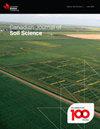在不同树种的两种林分中,凋落物和土壤中碱和金属阳离子的淋失情况不同
IF 1.5
4区 农林科学
Q4 SOIL SCIENCE
引用次数: 0
摘要
了解森林土壤中阳离子的分布对森林管理很重要。在这里,我们评估了不同树种的两个林分中,垃圾中阳离子、钾(K+)、钠(Na+)、钙(Ca2+)、镁(Mg2+)、铁(Fe3+)、铝(Al3+)和锰(Mn2+)在土壤中的浸出情况。我们采用微观方法,每月收集落叶和土壤渗滤液,分别在红锥林分中培育红锥落叶和在杉木林分中培育杉木针叶,并分别评估这些阳离子的浓度和通量。我们发现,由于新鲜枯枝落叶中Ca2+、Mg2+和Fe3+的初始浓度不同,杉木枯枝落叶浸提液中的Ca2+通量比红锥高,而Na+、Mg3+和Fe3+通量却比红锥低。尽管不同树种从落叶中浸出的阳离子不同,但不同林分的浸出通量没有变化。此外,从土壤中浸出的阳离子的年通量显著高于从落叶中浸出的离子,导致土壤养分向下游环境的净损失。因此,研究结果表明,在杉木单作林中引入阔叶树进行混交林造林,可以通过淋溶途径减少土壤养分损失。本文章由计算机程序翻译,如有差异,请以英文原文为准。
Leaching of base and metal cations from litter and soils vary in two forest stands with different tree species
Understanding the distribution of cations in forest soils is important for forest management. Here we evaluated the leaching of cations, potassium (K+), sodium (Na+), calcium (Ca2+), magnesium (Mg2+), iron (Fe3+), aluminium (Al3+), and manganese (Mn2+) from litter through soils in two forest stands with different tree species. We incubated Castanopsis carlesii leaf litter in a Castanopsis carlesii stand and Cunninghamia lanceolata needle litter in a Cunninghamia lanceolata stand using a microcosm method with monthly collections of litter and soil leachates, and the concentrations of cations and fluxes of these cations were assessed separately. We found that more Ca2+ but less Na+, Mg2+ and Fe3+ fluxes in litter leaching solutions in Cunninghamia lanceolata than in Castanopsis carlesii stand because of their different initial concentrations in fresh litter. Although cations leached from leaf litter were differed among tree species, the leaching fluxes did not vary between stands. Moreover, annual fluxes of cations leached from soils were significantly higher than those from leaf litter, leading to a net loss of soil nutrients to downstream environment. Therefore, the results suggest that reforestation with mixed stands by introducing broadleaved trees in Chinese fir monoculture plantations might reduce soil nutrient loss through the leaching pathway.
求助全文
通过发布文献求助,成功后即可免费获取论文全文。
去求助
来源期刊

Canadian Journal of Soil Science
农林科学-土壤科学
CiteScore
2.90
自引率
11.80%
发文量
73
审稿时长
6.0 months
期刊介绍:
The Canadian Journal of Soil Science is an international peer-reviewed journal published in cooperation with the Canadian Society of Soil Science. The journal publishes original research on the use, management, structure and development of soils and draws from the disciplines of soil science, agrometeorology, ecology, agricultural engineering, environmental science, hydrology, forestry, geology, geography and climatology. Research is published in a number of topic sections including: agrometeorology; ecology, biological processes and plant interactions; composition and chemical processes; physical processes and interfaces; genesis, landscape processes and relationships; contamination and environmental stewardship; and management for agricultural, forestry and urban uses.
 求助内容:
求助内容: 应助结果提醒方式:
应助结果提醒方式:


